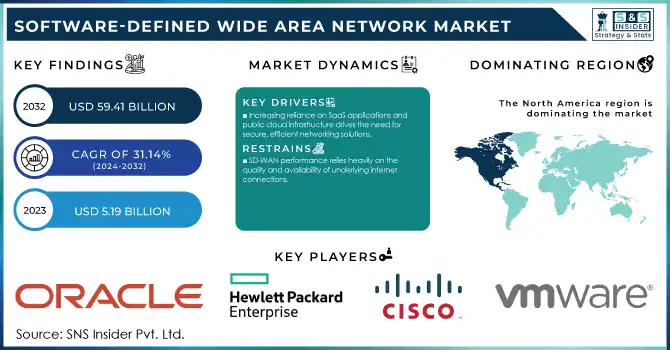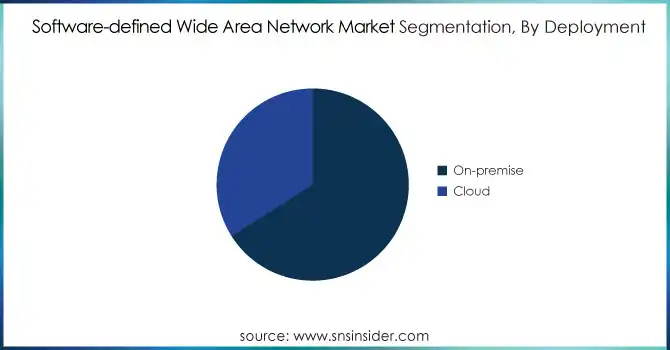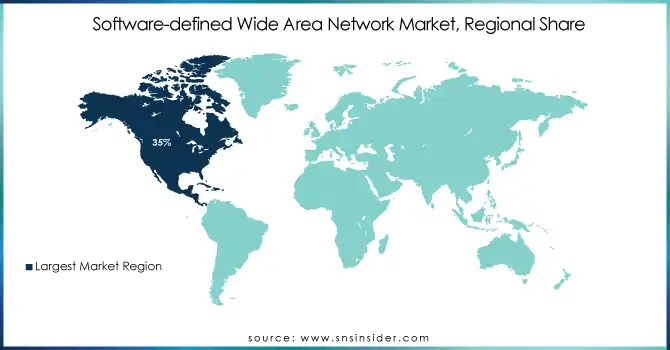Software-defined Wide Area Network Market Report Scope & Overview:
The Software-defined Wide Area Network Market was valued at USD 5.19 Billion in 2023 and is expected to reach USD 59.41 Billion by 2032, growing at a CAGR of 31.14% from 2024-2032.

To get more information on Software-Defined Wide Area Network Market - Request Free Sample Report
The Software-Defined Wide Area Network market is characterized by increasing growth, as businesses seek low-cost, flexible, high-performance networking solutions. As companies are facing several challenges like cloud migration, redefining the job of an enterprise, remote workforce, and working on providing free, seamless, and secure communication between branch offices and data centers, SD-WAN technology plays a long role in providing improved connectivity with low latencies and better application performances with centralized management in a software-based approach. For the SD-WAN market, increasing adoption of cloud-based applications and services is identified to be one of the major drivers of market growth. With SaaS platforms and public cloud infrastructure taking a bigger share of the pie in enterprise IT, the demand for secure and efficient data transfer has reached a whole new level. Furthermore, the expansion of remote and hybrid work models only increases the need for SD-WAN solutions that provide consistent and secure connections to your distributed workers.
Emphasis on network security is one of the important factors driving SD-WAN adoption. As cyber threats continue to climb, many solution provides advanced security features like encryption, firewalls, and more to make sure our data is secure. This is part of a larger trend towards integrating networking and security, which we have seen in secure access service edge frameworks.
Recent statistics show how much growth potential the market has, as more than 60% of organizations deploying SD-WAN consume a 40-50% reduction in network operational costs and prove its return-on-investment value. The expansion of 5G networks is anticipated to drive the proliferation of SD-WAN, enabling enhanced bandwidth and lower latency in industries such as healthcare, retail, and manufacturing. Furthermore, the recent enhancements in AI-guided analytics and automation, facilitating dynamic bandwidth provisioning and predictive maintenance are also augmenting the market by delivering better services and enhancing operational efficiency. Driven by advancing digital transformation and a growing number of small and medium businesses.
The expansion of the SD-WAN market is fueled by increased dependence on cloud services, the transition to working from home, and increased security requirements and technological advancements to provide organizations with operational efficiency and cost savings.
Software-defined Wide Area Network Market Dynamics
Drivers
-
Increasing reliance on SaaS applications and public cloud infrastructure drives the need for secure, efficient networking solutions.
As countless organizations moved to cloud-based platforms such as Microsoft 365, Salesforce, and Google Workspace, there came a heightened demand for secure, efficient, and reliable connectivity. Standard WANs are typically unable to accommodate the bandwidth-heavy, latency-sensitive requirements of these applications, especially for remote teams and distributed physical sites. SD-WAN solves this problem as it allows dynamic routing of traffic to optimize the performance of cloud-based services. SD-WAN allows businesses to place critical cloud apps first, balance network load, and reduce latency through software-based controls and centralized management. This capability is essential to protect employee productivity and to ensure the continuity of a smooth user experience, which is crucial in hybrid workplaces where employees connect to cloud services from anywhere. Moreover, SD-WAN also incorporates security tools to be part of their services such as encryption and also direct to cloud access being of the SD-WAN service with native protection reducing the threat of data loss and unauthorized access.
SD-WAN also supports a variety of connection types including broadband, LTE, and MPLS and this scalability comes at a much lower cost, appealing to organizations that are aligning with cloud-first strategies. The value it offers is further enhanced by its seamless integration with public cloud providers, enabling enterprises to handle their increased reliance on SaaS apps with maximum efficiency. As a result, SD-WAN has emerged as a critical technology for enterprises looking to transform their networks in a cloud-first world.
-
Sectors like healthcare, retail, and manufacturing require SD-WAN to support IoT, cloud, and edge applications.
-
Integration of advanced security features like firewalls and encryption addresses growing cyber threats.
Restraints
-
SD-WAN performance relies heavily on the quality and availability of underlying internet connections.
The effectiveness of a Software-Defined Wide Area Network solution depends heavily on the quality and availability of the underlying internet connections. In contrast to traditional WANs that rely on dedicated MPLS circuits, SD-WAN combines a variety of broadband, LTE and other internet links to provide a flexible and lower cost solution. However, the optimization of network performance, minimizing latency, and enabling seamless application delivery powered by SD-WAN depends on the speed and reliability of that connectivity. SD-WAN shines in areas where the underlying internet infrastructure is strong and resilient, routing dynamic packets over the best available paths to achieve high performance. In contrast, poor or spotty internet availability can create severe headaches for SD-WAN, including packet loss, greater latency, or a bad application experience. This is especially an issue for high bandwidth, low latency applications, like video conferencing, real-time collaboration tools, and cloud services. Even though SD-WAN solutions come with dynamic path selection and failover capabilities to cope with changing network conditions, the fundamentals are limited to the quality of the internet connections. This means that organizations working in remote or underdeveloped areas may have to dedicate resources to additional infrastructure or hybrid solutions to fill these gaps. Consequently, the availability of dependable internet connection continues to be one of the most important factors affecting enterprises in adopting SD-WAN and the overall success of such implementations.
-
The upfront investment in SD-WAN hardware, software, and skilled professionals can be a barrier for small and medium-sized enterprises (SMEs).
-
Integrating SD-WAN with existing legacy systems and networks can be challenging and time-consuming.
Software-defined Wide Area Network Market Segment Analysis
By Component
The Solution segment dominated the market and represented a significant revenue share of 61%, primarily generating revenue due to the increasing demand for an efficient, cost-effective, and secure networking solution. SD-WAN has become the new norm in organizations that want to maximize bandwidth usage, increase application performance, and bolster network security. With the increasing worldwide adoption of cloud services and remote work models, this growth is further accelerated by the need for seamless connectivity between distributed environments. Similarly, as businesses rapidly transition to a cloud-first direction, having access to more scalable, flexible, and secure network architecture using SD-WAN Solutions is turning out to be increasingly significant for organization providers. The solutions segment will also continue its growth from now through 2032 with the help of AI-driven analytics, automation, and seamless cloud integration.
The services segment is expected to register the fastest CAGR during the forecast period, due to the increasing requirement for managed services, support, and consulting to implement and optimize SD-WAN solutions. With the challenges of integrating SD-WAN with existing networks, organizations increasingly turn to service providers for full-blown solutions that include installation, monitoring, and maintenance. As networks become more complex to manage and security and performance needs increase, so will the need for these services, As an increasing number of enterprises look for specialized knowledge on how to get the most out of SD-WAN and also need assistance with seamless and efficient operations.
By Deployment
The on-premise segment dominated the market and accounted for the largest share of 68% in 2023, as a vast majority of enterprises continue to practice control over their network infrastructure. Sectors having high data privacy and security requirements like finance and healthcare often prefer on-premise solutions to manage sensitive data with complete control. On-premise SD-WAN also provides more personalization and combination with the implemented legacy systems. Driven by data sovereignty needs and network security, the on-premise section is anticipated to remain stable growth during the forecast period in 2032. This is even more true for such regulated sectors.
The cloud segment is expected to register the fastest CAGR during the forecast period, Driven by a growing adoption of cloud-based applications and services and increased hybrid and remote work. Cloud-based SD-WAN provides a high level of scalability, flexibility, and cost efficiency, allowing organizations to scale according to changing business requirements. The increasing adoption of SaaS and the movement of most workloads to the cloud is the backdrop of this trend. With businesses adopting cloud-first approaches, cloud-native SD-WAN solutions are an essential building block in modern network architectures.

Regional Analysis
North America dominated the Software-Defined Wide Area Network Market and represented a significant revenue share of more than 35% in 2023, as the region is the first adopter of advanced networking market solutions and has significant growth of key players in this market. It is expanding the SD-wan market through increasing demand for cloud applications, remote work solutions, and secure networking infrastructure across finance, healthcare, and manufacturing sectors within the region. America else has a well-developed IT infrastructure and a high tradition of innovation. With the ongoing modernization of network architectures — emphasizing security and efficiency — North America will remain the leader with consistent growth through 2032.
Asia-Pacific is expected to register the fastest CAGR during the forecast period, Rapid digital transformation, a growing internet penetration, and the expansion of small and medium enterprises are some of the factors that are fueling growth in the SD-WAN market in the Asia-Pacific region, Emerging nations like China, India & Japan are heavily investing in cloud infrastructure & advanced networking tech, thereby generating high demand for SD-WAN. Which includes the rise of remote work, IoT adoption, and the need for secure and scalable networks are some of the prominent growth factors in the region. As businesses continue to digitalise and the knowledge of benefits such as SD-WAN grows.

Get Customized Report as per Your Business Requirement - Enquiry Now
Key Players:
The major players are Oracle Corporation, Hewlett Packard Enterprise Company., Cisco Systems, Inc., Nokia Corporation, VMWare, Inc., Huawei Technologies, Fortinet, Juniper Networks, Palo Alto Networks, Silver Peak, Riverbed Technology, Aryaka Networks, and others in the final report.
Recent development:
January 2024: Cisco Systems announced the integration of advanced AI capabilities into its SD-WAN solutions, enhancing network optimization and security features.
February 2024: VMware Launched a new version of VMware SD-WAN by VeloCloud, offering improved scalability and performance for enterprise networks.
March 2024: Huawei Technologies Introduced Huawei CloudWAN, a cloud-based SD-WAN solution designed to provide seamless connectivity and enhanced security for global enterprises.
|
Report Attributes |
Details |
|
Market Size in 2023 |
USD 5.19 Billion |
|
Market Size by 2032 |
USD 59.41 Billion |
|
CAGR |
CAGR of 31.14% From 2024 to 2032 |
|
Base Year |
2023 |
|
Forecast Period |
2024-2032 |
|
Historical Data |
2020-2022 |
|
Report Scope & Coverage |
Market Size, Segments Analysis, Competitive Landscape, Regional Analysis, DROC & SWOT Analysis, Forecast Outlook |
|
Key Segments |
• By Component (Solution, Services) |
|
Regional Analysis/Coverage |
North America (USA, Canada, Mexico), Europe |
|
Company Profiles |
Cisco Systems, VMware, Huawei Technologies, Fortinet, Juniper Networks, Palo Alto Networks, Silver Peak, Riverbed Technology, Aryaka Networks |
|
Key Drivers |
• Sectors like healthcare, retail, and manufacturing require SD-WAN to support IoT, cloud, and edge applications. |
|
Restraints |
• The upfront investment in SD-WAN hardware, software, and skilled professionals can be a barrier for small and medium-sized enterprises. |

